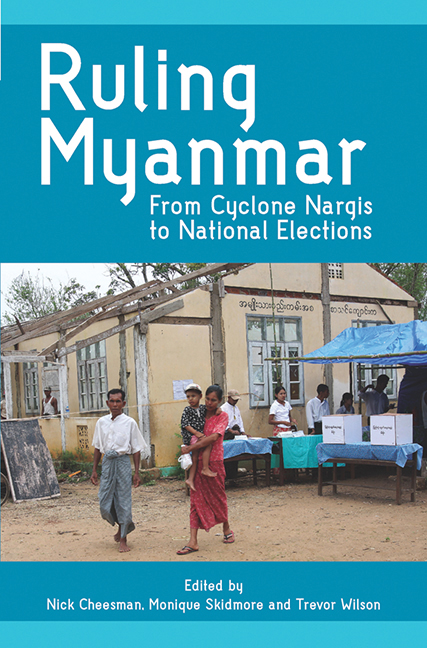Book contents
- Frontmatter
- Contents
- List of Tables
- List of Figures
- Background on ANU 2009 Myanmar/Burma Update Conference
- Acknowledgements
- Contributors and Editors
- Note on Terminology and Geographical Names
- Map of Myanmar
- Part I Overview
- 1 Perspectives on a Transitional Situation
- Part II Political Legitimacy, Governance and Justice
- Part III Economic Development, the Rural Economy and Labour Rights
- Part IV The Role of International Cooperation and Governance
- List of Abbreviations
- Index
1 - Perspectives on a Transitional Situation
from Part I - Overview
Published online by Cambridge University Press: 21 October 2015
- Frontmatter
- Contents
- List of Tables
- List of Figures
- Background on ANU 2009 Myanmar/Burma Update Conference
- Acknowledgements
- Contributors and Editors
- Note on Terminology and Geographical Names
- Map of Myanmar
- Part I Overview
- 1 Perspectives on a Transitional Situation
- Part II Political Legitimacy, Governance and Justice
- Part III Economic Development, the Rural Economy and Labour Rights
- Part IV The Role of International Cooperation and Governance
- List of Abbreviations
- Index
Summary
BACKGROUND: POLITICAL AND ECONOMIC CHALLENGES TO AUTHORITY
Significant changes in Myanmar/Burma since the popular demonstrations of 2007 mask a situation that seems superficially to be “more of the same”. The adoption of a new constitution, through a referendum conducted under questionable arrangements in May 2008, on paper restores a form of legal governance for the first time since 1988. However, few observers, in Myanmar or outside, have any illusions that this will mean a real transfer of power to a popularly elected government. Yet increasingly commentators and interested parties are taking the view that the elections, scheduled to take place in 2010 for the first time since 1990, at both the nationwide and regional level, will mark a new or accelerated phase in the agonizingly slow transitions purported to be occurring to bring about an end to military rule, even if they do not purport to restore participative government. This situation represents a major challenge for the citizens of Myanmar/Burma, whose ability to influence state decision-making is extraordinarily constrained, as well as for the international community.
Myanmar's military regime, the State Peace and Development Council (SPDC), not only maintains its tight grip on power, but since 2007 has moved to reduce further the space in which its authority can be contested and challenged. During 2008/09, the regime intensified its military campaigns against its opponents along its eastern border with Thailand. A new crackdown against political opponents during 2008, apparently aimed at weakening opposition groups before the 2010 elections, resulted in more than 2,100 political prisoners, more than at any other time in the modern period. Throughout 2009, the military leadership orchestrated a concerted (but poorly executed) campaign to convert armed minority groups into border security forces but, as tensions rose in August 2009, fighting between the army and the Kokang militia resulted in the first serious breakdown among the various ceasefire groups. The military regime has, however, still not been significantly challenged politically, despite the new array of sanctions (imposed outside the United Nations) since the 2007 crackdown against civil protests. Those UN Security Council members supporting Myanmar maintain their support, even though during 2008 they occasionally urged the military regime to cooperate more fully with the United Nations, as the UN's apparent impotence in dealing with the problem of Myanmar/Burma continued.
- Type
- Chapter
- Information
- Ruling MyanmarFrom Cyclone Nargis to National Elections, pp. 3 - 16Publisher: ISEAS–Yusof Ishak InstitutePrint publication year: 2010



